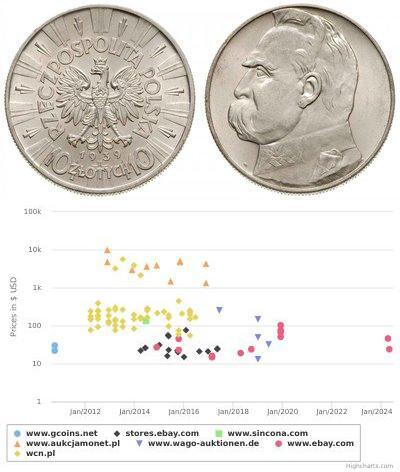1 Tetradrachm Seleucid Empire (312BC-63 BC) Silver Alexander I Ba ...
Seleucid Empire, Alexander I Balas (150-145 BC) AR Tetradrachm Coin.
Mint Place: Antioch on the Orontes Mint Period: dated SE 164 (149/8 BC). Reference: SC 1782.3d; HGC 9, 875a. Denomination: AR Tetradrachm (Four Drachmai) Diameter: 28mm Weight: 16.4gm Material: Silver
Obverse: Diademed head of Alexander I Balas right. Decorative border around.
Reverse: Zeus Nikephoros enthroned left; monogram to inner left. Legend: BAΣIΛEΩΣ AΛEΞANΔPOY / ΘEOΠATOPOΣ EYEPΓETOY
The tetradrachm (Greek: τετράδραχμον) was an Ancient Greek silver coin equivalent to four drachms. It was in wide circulation from 510 to 38 BC. The currency’s use was also popular in Greek-influenced areas of present-day Persia and India.
em>.
Alexander Balas (Ancient Greek: Ἀλέξανδρoς Bάλας), ruler of the Greek Seleucid kingdom in 150–146 BC, was a native of Smyrna of humble origin, but gave himself out to be the son of Antiochus IV Epiphanes and Laodice IV and heir to the Seleucid throne. Along with his sister Laodice VI, the youngster Alexander was “discovered” by Heracleides, a former minister of Antiochus IV and brother of Timarchus, an usurper in Media who had been executed by the reigning king Demetrius I Soter.
Alexander’s claims were recognized by the Roman Senate, Ptolemy Philometor of Egypt and others. He married Cleopatra Thea, a daughter of the Ptolemaic dynasty. At first unsuccessful, Alexander finally defeated Demetrius Soter in 150 BC. Being now master of the empire, he is said to have abandoned himself to a life of debauchery. Whatever the truth behind this, the young king was forced to depend heavily on his Ptolemaic support and even struck portraits with the characteristic features of king Ptolemy I.
Demetrius Soter’s son Demetrius II profited by the opportunity to regain the throne. Ptolemy Philometor, who was Alexander’s father-in-law, went over to his side, and Alexander was defeated in the battle of Antioch (145 BC) in Syria, sometimes known as the battle of the Oenoparus.
He fled for refuge to a Nabataean prince, who murdered him and sent his head to Ptolemy Philometor, who had been mortally wounded in the engagement.
View all coins in the group
(1005 X 524pixels, file size: ~146K)
Posted by: anonymous 2015-02-28
Seleukid Kingdom. Alexander I Balas. Silver Tetradrachm (16.5 g), 152/1-145 BC. Antioch on the Orontes. SE 163 (150/49 BC). Diademed head of Alexander I right. Reverse BAΣIΛEΩΣ AΛEΞANΔPOY ΘEOΠATOPOΣ EYEPΓETOY, Zeus seated left, holding Nike and scepter; in outer left field, cornucopiae; in exe ...
(505 X 256pixels, file size: ~37K)
Posted by: anonymous 2015-02-24
SYRIA, Kingdom of, Alexander I Balas, (150-145 B.C.), silver tetradrachm, (16.214 grams), Seleucia on the Tigris mint, obv. diademed head of Alexander I to right, ...
(1057 X 472pixels, file size: ~106K)
Posted by: anonymous 2014-09-07
Seleucid Kings of Syria, Alexander I Balas (150-145 BC) AR Tetradrachm Coin. R! Mint Place: Antioch Mint Period: 148-147 BC Denomination: AR Tetradrachm (Four Drachmai) Reference: SC 1781.1i, SNG Spaer -, SMA 167. R! Condition: Minor traces of corrosion and few scratches, otherwi ...
(1005 X 450pixels, file size: ~105K)
Posted by: anonymous 2014-05-05
Seleucid Kings of Syria, Alexander I Balas (150-145 BC) AR Tetradrachm Coin. R! Mint Place: Antioch Mint Period: 148-147 BC Reference: SC 1784.2. R! Denomination: AR Tetradrachm (Four Drachmai) Condition: Minor traces of corrosion, otherwise about XF! Weight: 16.37gm Diameter: 30m ...
(1005 X 462pixels, file size: ~107K)
Posted by: anonymous 2014-03-21
Seleucid Kings of Syria, Alexander I Balas (149/148 BC) AR Tetradrachm Coin. R! Mint Place: Antioch Mint Period: 149/148 BC (Year 164) Denomination: AR Tetradrachm (Four Drachmai) Reference: SC 1782.2d; DCA 118; HGC 9, 875a. R! Condition: Lightly cleaned, traces of corrosion in re ...
|

-500-250-SXMKbzbiYkMAAAFLfijk0Ljz.jpg)
-300-150-WEoKbzbiIgYAAAFLS26jls20.jpg)
-300-150-SXMKbzbiYkMAAAFLfijk0Ljz.jpg)
-300-150-kPoKbzbijOcAAAFIhnJXaU5F.jpg)
-300-150-RQoKb0OMEucAAAFFjr1qTMoQ.jpg)
-300-150-Fu8Kb0OMN0EAAAFEG1tuUOVA.jpg)













